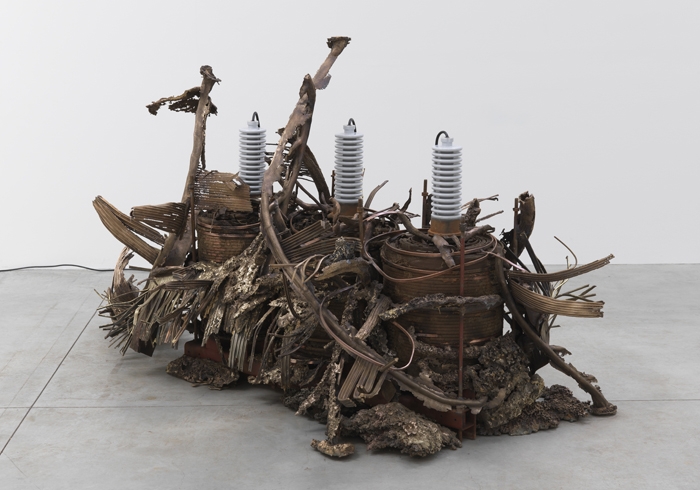Lisson Gallery, London, 22 September–11 November
Responding to criticism of the disaster relief supplied to Puerto Rico in the wake of Hurricane Maria, Donald Trump explained, with unimpeachable factual accuracy, that it is ‘an island sitting in the middle of an ocean… a big ocean, a very big ocean’. Its geographical isolation was the chief reason, he insisted, that less US aid had reached the archipelago than the similarly crisis-hit states of Texas and Florida.
A more convincing explanation for the disparity is contained in the title of Allora & Calzadilla’s timely exhibition, which adopts the US Supreme Court’s historic definition of Puerto Rico as ‘foreign in a domestic sense’. The 1901 verdict on a trade dispute established the territory as simultaneously within and without the United States, a colonial possession denied the rights afforded to incorporated states. The implications of this oxymoronic ruling – despite being US citizens, for example, Puerto Ricans cannot vote in the presidential election – continue to shape the unequal relationship between protectorate and protector.
If it’s not immediately clear how the wall-mounted and freestanding sculptures at Lisson give formal expression to this association, then the listed materials give them away. Across adjacent walls hangs Manifest (2017), its two hulking forms resembling ship engines, each a rust-coloured tangle of metal pistons and pipes caked in bat guano. Combining a metonym for global traffic with a natural resource that was once a tradable commodity, the work alludes to the early days of US overseas imperialism, specifically the Guano Islands Act of 1856 which legalised the annexation of any unclaimed islands rich in the fertiliser upon which an agricultural economy depended. I say ‘give them away’ because, having discharged their purpose in alerting the viewer to this colonialist history, the sculptures feel drained of affective power.
The same literalism hinders Loss (2017), a string bag of oranges cast in black wax and propped against the wall. Again the work relates to a specific event, the import tax dispute that led to the Supreme Court’s fudged ruling, and again it is both blandly transparent (if you are familiar with the context) and frustratingly opaque (if you are not). The work attests to an injustice but, beyond using black as a signifier of mourning, does little to summon the suffering not captured by the dry language of historical record. Exhibited in a side room, a video (The Night We Became People Again, 2017) composed of slow tracking shots of Puerto Rican locations – a cave which hosts an installation by the artists, an abandoned factory – calls to mind Amie Siegel’s Provenance (2013) and Quarry (2015), both of which document the global movement of goods and services. By counterpointing the contemplative beauty of the images with desolate scenes that hint at the exodus of Puerto Rican workers to the mainland, the artists generate an ambivalence that is elsewhere lacking.
The most compelling work in the exhibition, Blackout (2017), resembles an eviscerated animal carcass rendered in twisted strips of frayed metal. Composed from the reconstituted parts of a transformer destroyed by an explosion at a Puerto Rican electricity station, the work plays on the unequal transfer of power even as it flags up a domestic energy crisis exacerbated by unserviceable debts to the United States. The structure emits a menacing voltaic buzz, establishing an uneasy atmosphere in the space that is at first heightened and then transformed by a twice-weekly performance by a choral ensemble (mains hum, 2017).
The show’s title suggests that Allora & Calzadilla aim to explore the doublespeak definition of what it means to be Puerto Rican – foreign and domestic, other and same – through the juxtaposition of disparate objects, materials and media. It’s a strategy premised on metaphor, the association of one thing with another, that the Surrealists valued for its capacity to generate unpredictable, polysemous and hybrid meanings. Yet Allora & Calzadilla maintain a firm control over how their work can be read, pitting themselves against the linguistic ambiguity that makes possible such ethical evasions as ‘foreign and domestic’ or ‘war on terror’. Poetic metaphor is ill-suited to the task of re-establishing the authority of ordinary language, however urgent the cause. It’s a bind from which the artists fail to escape.
From the December 2017 issue of ArtReview
